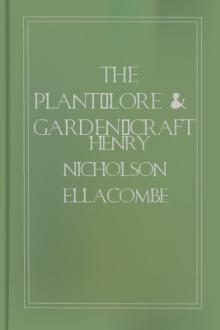The plant-lore & garden-craft of Shakespear, Henry Nicholson Ellacombe [read with me .TXT] 📗

- Author: Henry Nicholson Ellacombe
- Performer: -
Book online «The plant-lore & garden-craft of Shakespear, Henry Nicholson Ellacombe [read with me .TXT] 📗». Author Henry Nicholson Ellacombe
But though Shakespeare's Knot-grass is undoubtedly the Polygonum, yet the name was also given to another plant, for this cannot be the plant mentioned by Milton—
Had ta'en their supper on the savoury herb
Of Knot-grass dew-besprent."—Comus.
In this case it must be one of the pasture Grasses, and may be Agrostis stolonifera, as it is said to be in Aubrey's "Natural History of Wilts" (Dr. Prior).
LADY-SMOCKS. Song of Spring. And Lady-smocks all silver-white,And Cuckoo-buds of yellow hue,
Do paint the meadows with delight. Love's Labour's Lost, act v, sc. 2 (905).
Lady-smocks are the flowers of Cardamine pratensis, the pretty early meadow flower of which children are so fond, and of which the popularity is shown by its many names: Lady-smocks, Cuckoo-flower,[134:1] Meadow Cress, Pinks, Spinks, Bog-spinks, and May-flower, and "in Northfolke, Canterbury Bells." The origin of the name is not very clear. It is generally explained from the resemblance of the flowers to smocks hung out to dry, but the resemblance seems to me rather far-fetched. According to another explanation, "the Lady-smock, a corruption of Our Lady's-smock, is so called from its first flowering about Lady-tide. It is a pretty purplish white, tetradynamous plant, which blows from Lady-tide till the end of May, and which during the latter end of April covers the moist meadows with its silvery-white, which looks at a distance like a white sheet spread over the fields."—Circle of the Seasons. Those who adopt this view called the plant Our Lady's-smock, but I cannot find that name in any old writers. Drayton, coeval with Shakespeare, says—
Of Lady-smocks most white do rob each neighbouring mead,
Wherewith their loose locks most curiously they braid."
And Isaac Walton, in the next century, drew that pleasant picture of himself sitting quietly by the waterside—"looking down the meadows I could see here a boy gathering Lilies and Lady-smocks, and there a girl cropping Culverkeys and Cowslips."[134:2]
There is a double variety of the Lady-smock which makes a handsome garden plant, and there is a remarkable botanical curiosity connected with the plant which should be noticed. The plant often produces in the autumn small plants upon the leaves, and by the means of these little parasites the plant is increased, and even if the leaves are detached from the plant, and laid upon moist congenial soil, young plants will be produced. This is a process that is well known to gardeners in the propagation of Begonias, and it is familiar to us in the proliferous Ferns, where young plants are produced on the surface or tips of the fronds; and Dr. Masters records "the same condition as a teratological occurrence in the leaves of Hyacinthus Pouzolsii, Drosera intermedia, Arabis pumila, Chelidonum majus, Chirita Sinensis, Epicia bicolor, Zamia, &c."—Vegetable Teratology, p. 170.
FOOTNOTES:[134:1] "Ladies-smock.—A kind of water cresses, of whose virtue it partakes; and it is otherwise called Cuckoo-flower."—Phillips, World of Words, 1696.
[134:2] Culverkeys is mentioned in Dennis' "Secrets of Angling" as a meadow flower: "pale Ganderglas, and azor Culverkayes." It is also mentioned by Aubrey, in his "Natural History of Wilts;" but the name is found in no other writer, and is now extinct. It is difficult to say what plant is meant; many have been suggested: the Columbine, the Meadow Orchis, the Bluebell, &c. I think it must be the Meadow Geranium, which is certainly "azor" almost beyond any other British plant. "Culver" is a dove or pigeon, and "keyes" or "kayes" are the seeds of a plant, and the seeds of the Geranium were all likened to the claws of birds, so that our British species is called G. columbinum.
LARK'S HEELS. Larks heels trim. Two Noble Kinsmen, Introd. song.Lark's heels is one of the many names of the Garden Delphinium, otherwise called Larkspur, Larksclaw, Larkstoes.
LAUREL. (1) Clarence. To whom the heavens in thy nativityAdjudged an Olive branch and Laurel crown
As likely to be blest in peace and war. 3rd Henry VI, act iv, sc. 6 (33). (2) Titus. Cometh Andronicus bound with Laurel boughs. Titus Andronicus, act i, sc. 1 (74). (3) Cleopatra. Upon your sword
Sit Laurel victory. Antony and Cleopatra, act i, sc. 3 (99). (4) Ulysses. Prerogative of age, crowns, sceptres, Laurels. Troilus and Cressida, act i, sc. 3 (107).
This is one of the plants which Shakespeare borrowed from the classical writers; it is not the Laurel of our day, which was not introduced till after his death,[136:1] but the Laurea Apollinis, the Laurea Delphica—
And poet's sage,"—Spenser;
that is, the Bay. This is the tree mentioned by Gower—
Was turned, whiche is ever grene,
In token, as yet it may be sene,
That she shalle dwelle a maiden stille."
Conf. Aman. lib. terc.
There can be little doubt that the Laurel of Chaucer also was the Bay, the—
That gave so passing a delicious smelle
According to the Eglantere ful welle."
He also spoke of it as the emblem of enduring freshness—
As Laurer, through the yeer is for to seene."
The Marchaundes Tale.
The Laurel in Lyte's "Herbal" (the Lauriel or Lourye) seems to be the Daphne Laureola. But unconsciously Chaucer and Shakespeare spoke with more botanical accuracy than we do, the Bay being a true Laurel, while the Laurel is a Cherry (see Bay).
FOOTNOTES:[136:1] The first Laurel grown in Europe was grown by Clusius in 1576.
LAVENDER. Perdita. Here's flowers for you;Hot Lavender, Mints, Savory, Marjoram. Winter's Tale, act iv, sc. 4 (103).
The mention of Lavender always recalls Walton's pleasant picture of "an honest ale-house, where we shall find a cleanly room, Lavender in the windows, and twenty ballads stuck against the wall, and my hostess, I may tell you, is both cleanly and handsome and civil." Whether it is from this familiar, old-fashioned picture, or from some inherent charm in the plant, it is hard to say, but it is certain that the smell of Lavender is always associated with cleanliness and freshness.[137:1]
It is not a British plant, but is a native of the South of Europe in dry and barren places, and it was introduced into England in the sixteenth century, but it probably was not a common plant in Shakespeare's time, for though it is mentioned by Spenser as "the Lavender still gray" ("Muiopotmos"), and by Gerard as growing in his garden, it is not mentioned by Bacon in his list of sweet-smelling plants. The fine aromatic smell is found in all parts of the shrub, but the essential oil is only produced from the flowers. As a garden plant it is found in every garden, but its growth as an extensive field crop is chiefly confined to the neighbourhood of Mitcham and Carshalton in Surrey; and there at the time of the picking of the flowers, and still more in the later autumn when the old woody plants are burned, the air for a long distance is strongly and most pleasantly impregnated with the delicate perfume.
FOOTNOTES:[137:1] The very name suggests this association. Lavender is the English form of the Latin name, Lavendula; "lavendula autem dicta quoniam magnum vectigal Genevensibus mercatoribus præbet quotannis in Africam eam ferentibus, ubi lavandis fovendisque corporibus Lybes ea utuntur, nec nisi decocto ejus abluti, mane domo egrediuntur."—Stephani Libellus de re Hortensi, 1536, p. 54. The old form of our "laundress" was "a Lavendre."
LEATHERCOAT, see Apple. LEEK. (1) Thisbe. His eyes were green as Leeks. Midsummer Night's Dream, act v, sc. 1 (342). (2) Pistol. Tell him I'll knock his Leek about his pate upon Saint Davy's Day. Henry V, act iv, sc. 1 (54). (3) Fluellen. If your majesties is remembered of it, the Welshmen did good service in a garden where Leeks did grow, wearing Leeks in their Monmouth caps; which your majesty knows to this hour is an honourable badge of the service; and I do believe your majesty takes no scorn to wear the Leek upon Saint Tavy's Day. Ibid., act iv, sc. 7 (101). (4) In act v, sc. 1, is the encounter between Fluellen and Pistol, when he makes the bully eat the Leek; this causes such frequent mention of the Leek that it would be necessary to extract the whole scene, which, therefore, I will simply refer to in this way.We can scarcely understand the very high value that was placed on Leeks in olden times. By the Egyptians the plant was almost considered sacred, "Porrum et cæpe nefas violare et frangere morsu" (Juvenal); we know how Leeks were relished in Egypt by the Israelites; and among the Greeks they "appear to have constituted so important a part in ancient gardens, that the term πρασιά, or a bed, derived its name from πρασον, the Greek word for Onion," or Leek[138:1] (Daubeny); while among the Anglo-Saxons it was very much the same. The name is pure Anglo-Saxon, and originally meant any vegetable; then it was restricted to any bulbous vegetable, before it was finally further restricted to our Leek; and "its importance was considered so much above that of any other vegetable, that leac-tun, the Leek-garden, became the common name of the kitchen garden, and leac-ward, the Leek-keeper, was used to designate the gardener" (Wright). The plant in those days gave its name to the Broad Leek which is our present Leek, the Yne Leek or Onion, the Garleek (Garlick), and others of the same tribe, while it was applied to other plants of very different families, as the Hollow Leek (Corydalis cava), and the House Leek (Sempervivum tectorum).
It seems to have been considered the hardiest of all flowers. In the account of the Great Frost of 1608, "this one infallible token" is given in proof of its severity. "The Leek whose courage hath ever been so undaunted that he hath borne up his lusty head in all storms, and could never be compelled to shrink for hail, snow, frost, or showers, is now by the violence and cruelty of this weather beaten unto the earth, being rotted, dead, disgraced, and trod upon."
Its popularity still continues among the Welsh, by whom it is still, I believe, very largely cultivated; but it does not seem to have been much valued in England in Shakespeare's time, for Gerard has but little to





Comments (0)